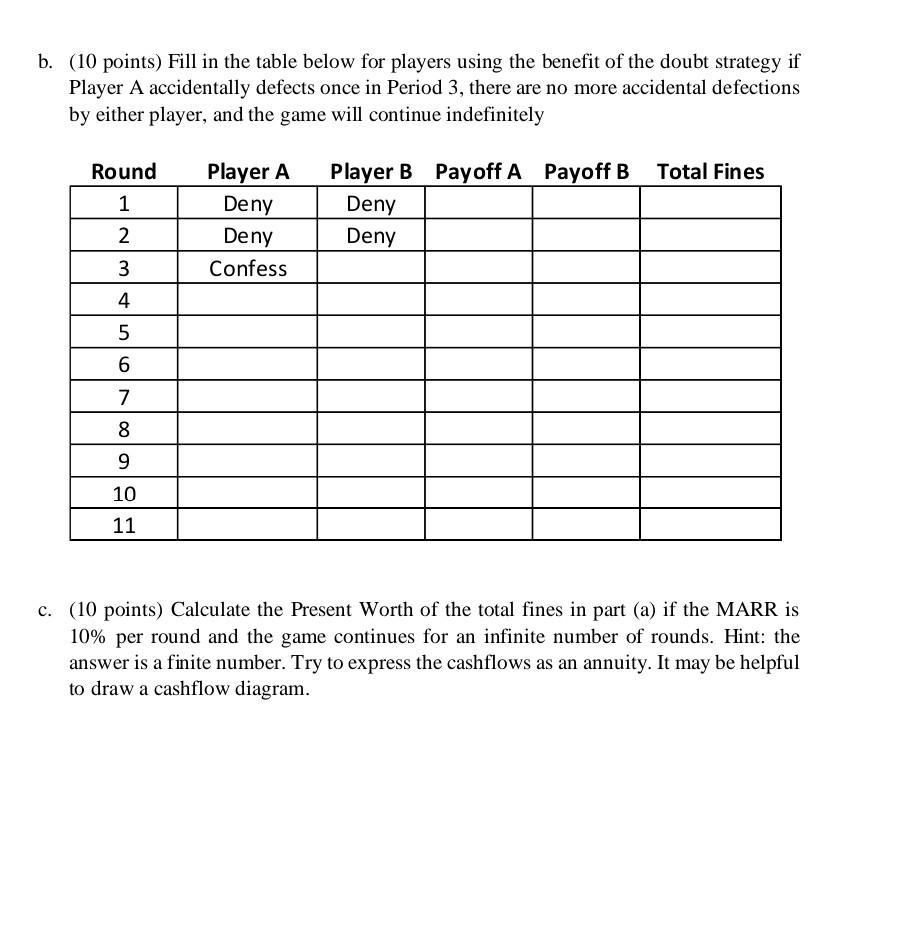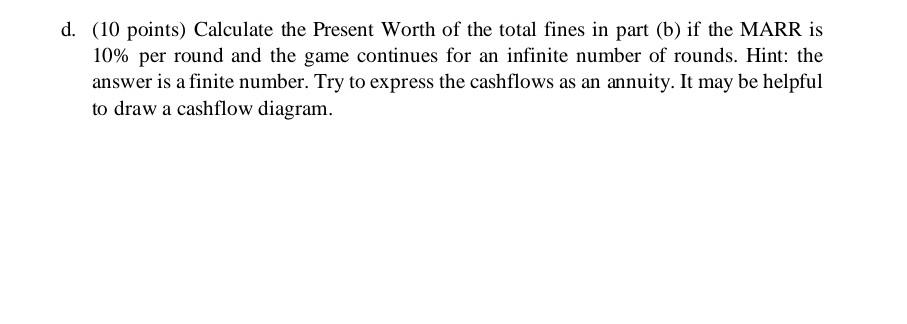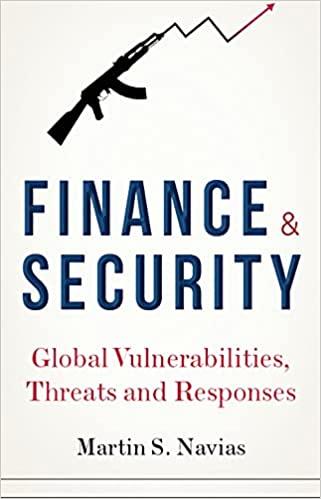Answered step by step
Verified Expert Solution
Question
1 Approved Answer
please Send me Answer as soon as possible 7) Consider the indefinitely repeated prisoner's dilemma, with payoffs as shown in the table below. For this



please Send me Answer as soon as possible
7) Consider the indefinitely repeated prisoner's dilemma, with payoffs as shown in the table below. For this problem, assume that the payoffs are fines, rather than jail time. The tit-for-tat strategy is to cooperate (deny) in the first round and then in every round thereafter do what your opponent did in the previous round. In other words, cooperate in the first round and for subsequent rounds unless opposing player defected (confessed) in the previous round, in which case you defect. The benefit of the doubt strategy is as follows: Each player cooperates unless the opponent defected for both of the previous two rounds. In other words, the first time the opponent defects, the payer will give the opponent the benefit of the doubt, assume the defection was a mistake, and cooperate. However, if the opponent defects twice in a row the player will assume that the defection is deliberate and retaliate by defecting themselves. Player B Confess Deny Confess -$4, -$4 $0, -$7 Player A Deny -$7,0 -$2,-$2 a. (10 points) Fill in the table below for players using the tit-for-tat strategy if Player A accidentally defects once in Period 3, there are no more accidental defections by either player, and the game will continue indefinitely Round Player A Player B Payoff A Payoff B Total Fines 1 Deny Deny 2 Deny Deny 3 Confess 4 5 6 7 8 9 10 11 b. (10 points) Fill in the table below for players using the benefit of the doubt strategy if Player A accidentally defects once in Period 3, there are no more accidental defections by either player, and the game will continue indefinitely Round Player A Player B Payoff A Payoff B Total Fines 1 Deny Deny 2 Deny Deny 3 Confess 4 5 7 8 9 10 11 c. (10 points) Calculate the Present Worth of the total fines in part (a) if the MARR is 10% per round and the game continues for an infinite number of rounds. Hint: the answer is a finite number. Try to express the cashflows as an annuity. It may be helpful to draw a cashflow diagram. 56 d. (10 points) Calculate the Present Worth of the total fines in part (b) if the MARR is 10% per round and the game continues for an infinite number of rounds. Hint: the answer is a finite number. Try to express the cashflows as an annuity. It may be helpful to draw a cashflow diagram. 7) Consider the indefinitely repeated prisoner's dilemma, with payoffs as shown in the table below. For this problem, assume that the payoffs are fines, rather than jail time. The tit-for-tat strategy is to cooperate (deny) in the first round and then in every round thereafter do what your opponent did in the previous round. In other words, cooperate in the first round and for subsequent rounds unless opposing player defected (confessed) in the previous round, in which case you defect. The benefit of the doubt strategy is as follows: Each player cooperates unless the opponent defected for both of the previous two rounds. In other words, the first time the opponent defects, the payer will give the opponent the benefit of the doubt, assume the defection was a mistake, and cooperate. However, if the opponent defects twice in a row the player will assume that the defection is deliberate and retaliate by defecting themselves. Player B Confess Deny Confess -$4, -$4 $0, -$7 Player A Deny -$7,0 -$2,-$2 a. (10 points) Fill in the table below for players using the tit-for-tat strategy if Player A accidentally defects once in Period 3, there are no more accidental defections by either player, and the game will continue indefinitely Round Player A Player B Payoff A Payoff B Total Fines 1 Deny Deny 2 Deny Deny 3 Confess 4 5 6 7 8 9 10 11 b. (10 points) Fill in the table below for players using the benefit of the doubt strategy if Player A accidentally defects once in Period 3, there are no more accidental defections by either player, and the game will continue indefinitely Round Player A Player B Payoff A Payoff B Total Fines 1 Deny Deny 2 Deny Deny 3 Confess 4 5 7 8 9 10 11 c. (10 points) Calculate the Present Worth of the total fines in part (a) if the MARR is 10% per round and the game continues for an infinite number of rounds. Hint: the answer is a finite number. Try to express the cashflows as an annuity. It may be helpful to draw a cashflow diagram. 56 d. (10 points) Calculate the Present Worth of the total fines in part (b) if the MARR is 10% per round and the game continues for an infinite number of rounds. Hint: the answer is a finite number. Try to express the cashflows as an annuity. It may be helpful to draw a cashflow diagramStep by Step Solution
There are 3 Steps involved in it
Step: 1

Get Instant Access to Expert-Tailored Solutions
See step-by-step solutions with expert insights and AI powered tools for academic success
Step: 2

Step: 3

Ace Your Homework with AI
Get the answers you need in no time with our AI-driven, step-by-step assistance
Get Started


